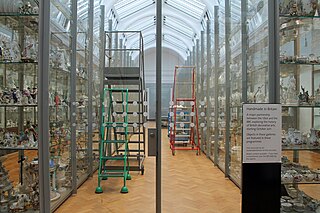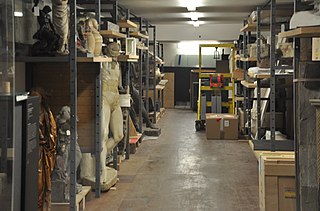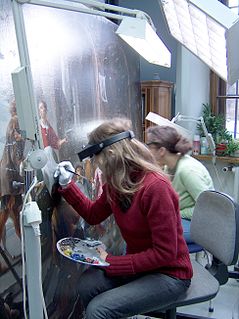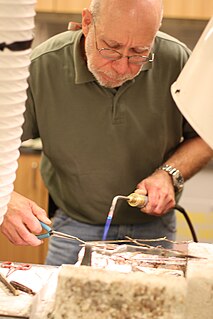
A curator is a manager or overseer. Traditionally, a curator or keeper of a cultural heritage institution is a content specialist charged with an institution's collections and involved with the interpretation of heritage material including historical artifacts.

A museum is distinguished by a collection of often unique objects that forms the core of its activities for exhibitions, education, research, etc. This differentiates it from an archive or library, where the contents may be more paper-based, replaceable and less exhibition oriented, or a private collection of art formed by an individual, family or institution that may grant no public access. A museum normally has a collecting policy for new acquisitions, so only objects in certain categories and of a certain quality are accepted into the collection. The process by which an object is formally included in the collection is called accessioning and each object is given a unique accession number.
The California Digital Library (CDL) was founded by the University of California in 1997. Under the leadership of then UC President Richard C. Atkinson, the CDL’s original mission was to forge a better system for scholarly information management and improved support for teaching and research. In collaboration with the ten University of California Libraries and other partners, CDL assembled one of the world's largest digital research libraries. CDL facilitates the licensing of online materials and develops shared services used throughout the UC system. Building on the foundations of the Melvyl Catalog, CDL has developed one of the largest online library catalogs in the country and works in partnership with the UC campuses to bring the treasures of California's libraries, museums, and cultural heritage organizations to the world. CDL continues to explore how services such as digital curation, scholarly publishing, archiving and preservation support research throughout the information lifecycle.
An inventory is an itemized list of cultural property items that the museum has accessioned or received via loan(s) and must be physically located by an examiner. A complete, one-hundred percent inventory, or a random inventory of the collection must be carried out periodically to ensure the museum is operating under best practices and for security purposes. The museum is legally responsible and ethically obligated for the maintenance of up-to-date information detailing the location of all objects within the collection, including loaned items and objects that have yet to be accessioned; this is stipulated by many museum associations, including the American Association of Museums.
A Collection Management Policy lays the foundation for how a museum handles situations pertaining to their collection. It can be defined as “a detailed written statement that explains why a museum is in operation and how it goes about its business. The policy articulates the museum’s professional standards regarding the objects left in its care and serves as a guide for the staff”. Since museums are often faced with questions that deal with what objects they should acquire, how to handle removing or loaning objects in the collection, or standards of care for objects; it is imperative to have a well-written policy that can help prevent possible issues on the museum's end. Prevention is the best approach when dealing with operations and objects in the collection, therefore the policy is an important document that can be looked at almost like boundaries set in place to help insure that the museum stays true to its mission while also providing the best care for the collection.

Collections care, which is sometimes called preventive conservation, involves any actions taken to prevent or delay the deterioration of cultural heritage. The primary goal is to identify and reduce potential hazards to heritage with thoughtful control of their surroundings. The professions most influenced by collections care include conservator-restorers, curators, collection managers, and registrars.

Collection maintenance is a form of collections care that consists of the day-to-day hands on care of collections and cultural heritage. The primary goal of collections maintenance is to prevent further decay of cultural heritage by ensuring proper storage and upkeep including performing regular housekeeping of the spaces and objects and monitoring and controlling storage and gallery environments. Collections maintenance is closely linked to collections care and collections management. The professionals most involved with collections maintenance include collection managers, registrars, and archivists, depending on the size and scope of the institution. Collections maintenance takes place in two primary areas of the museum: storage areas and display areas.

A collection manager ensures the proper care and preservation of objects within cultural institutions such as museums, libraries, and archives. Collection managers, along with registrars, curators, and conservators, play an important role in collections care. Collection Managers and Registrars are two distinct collection roles that are often combined into one within small to mid-size cultural institutions. Collection Managers can be found in large museums and those with a history and natural history focus whose diverse collections require experienced assessment to properly sort, catalog, and store artifacts. A collection manager may oversee the registrar, archivist, curator, photographer, or other collection professionals, and may assume the responsibilities of these roles in their absence within an organization.

A paintings conservator is an individual responsible for protecting cultural heritage in the form of painted works of art. These individuals are most often under the employ of museums, conservation centers, or other cultural institutions. They oversee the physical care of collections, and are trained in chemistry and practical application of techniques for repairing and restoring paintings.

A mount maker is responsible for the creation of structures called object mounts used to provide unobtrusive physical support, stability, and security of objects while on display, in storage, or being transported to museums, art galleries, libraries, archives, botanical gardens or other cultural institutions. Protection and long-term conservation of the object is a key goal of mount makers. This is accomplished through careful design, selection of materials and manufacturing process that will not inadvertently harm the object, and a cautious installation process of the object into its place in an exhibit. Professionals in this field can be employed directly by an institution, be independent contractors, or work as part of larger cultural institution exhibit design firms.

A museum/library/archival registrar is responsible for implementing policies and procedures that relate to caring for collections of cultural institutions like archives, libraries, and museums. These policies are found in the museum's collections policy, the guiding tenet of the museum explaining why the institution is in operation, dictating the museum's professional standards regarding the objects left in its care. Registrars focus on sections that include acquisitions, loans, exhibitions, deaccessions, storage, packing and shipping, security of objects in transit, insurance policies, and risk management.
Emergency response , refers to the measures taken to prepare for and respond to crisis situations that endanger collections, people, and building structures. Common types of emergencies include natural disasters, pests, terrorism, war, and theft or vandalism. These conditions make up 5 of the 10 primary agents of deterioration that effect the longevity of museum collections.
"Found in collection" (FIC) is a term used by a museum to refer to "undocumented objects that remain without status after all attempts to reconcile them to existing records of permanent collection and loan objects are completed". Despite the best efforts of museum staff, museums often have FIC items. This term was developed so that collections with incomplete provenance would be handled ethically and with transparency. Depending on the paperwork and information accompanying the material, the museum has several choices in how to proceed.

The documentation of cultural property is a critical aspect of collections care. As stewards of cultural property, museums collect and preserve not only objects but the research and documentation connected to those objects, in order to more effectively care for them. Documenting cultural heritage is a collaborative effort. Essentially, registrars, collection managers, conservators, and curators all contribute to the task of recording and preserving information regarding collections. There are two main types of documentation museums are responsible for: records generated in the registration process—accessions, loans, inventories, etc. and information regarding research on objects and their historical significance. Properly maintaining both types of documentation is vital to preserving cultural heritage.

A textile conservator is a conservator-restorer charged with the care, treatment, research, and preservation of textiles. Issues addressed by a textile conservator are generally related to the field of textile preservation, and include damage caused to textiles by: light, mold and mildew, insects, cleaning, surface cleaning, washing, mounting for display, and storage. Variations in textile types and “the diversity of the textile conservator’s work makes it a very rewarding profession”. Textiles are among the most fragile artifacts, as they are susceptible to damage from atmospheric pollutants, moisture, biological organisms, and environmental changes and care varies with size, shape, material, and condition issues, all of which a textile conservator must be well versed.
A Collections Management System (CMS), sometimes called a Collections Information System, is software used by the collections staff of a collecting institution or by individual private collectors and collecting hobbyists or enthusiasts. Collecting institutions are primarily museums and archives and cover a very broad range from huge, international institutions, to very small or niche-specialty institutions such as local historical museums and preservation societies. Secondarily, libraries and galleries are also collecting institutions. Collections Management Systems (CMSs) allow individuals or collecting institutions to organize, control, and manage their collections' objects by “tracking all information related to and about” those objects. In larger institutions, the CMS may be used by collections staff such as registrars, collections managers, and curators to record information such as object locations, provenance, curatorial information, conservation reports, professional appraisals, and exhibition histories. All of this recorded information is then also accessed and used by other institutional departments such as “education, membership, accounting, and administration."

The conservation and restoration of human remains involves the long-term preservation and care of human remains in various forms which exist within museum collections. This category can include bones and soft tissues as well as ashes, hair, and teeth. Given the organic nature of the human body, special steps must be taken to halt the deterioration process and maintain the integrity of the remains in their current state. These types of museum artifacts have great merit as tools for education and scientific research, yet also have unique challenges from a cultural and ethical standpoint. Conservation of human remains within museum collections is most often undertaken by a conservator-restorer or archaeologist. Other specialists related to this area of conservation include osteologists and taxidermists.

Deaccessioning is the process by which a work of art or other object is permanently removed from a museum's collection to sell it or otherwise dispose of it.

The conservation and restoration of flags and banners is the process by which conservators work to preserve and restore flags and banners from future deterioration and damage. As a part of Conservation of Textiles, flag and banner conservation require the care of a skilled and well trained textile conservator, specifically trained in historical materials.

The exhibition of cultural property is a practice used by organizations where collected objects are put on display to the public. The objects are carefully chosen and placed together to offer educational value, and often to tell a story.

















